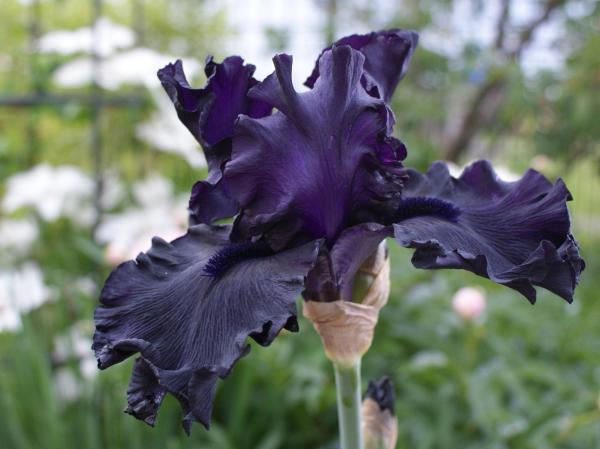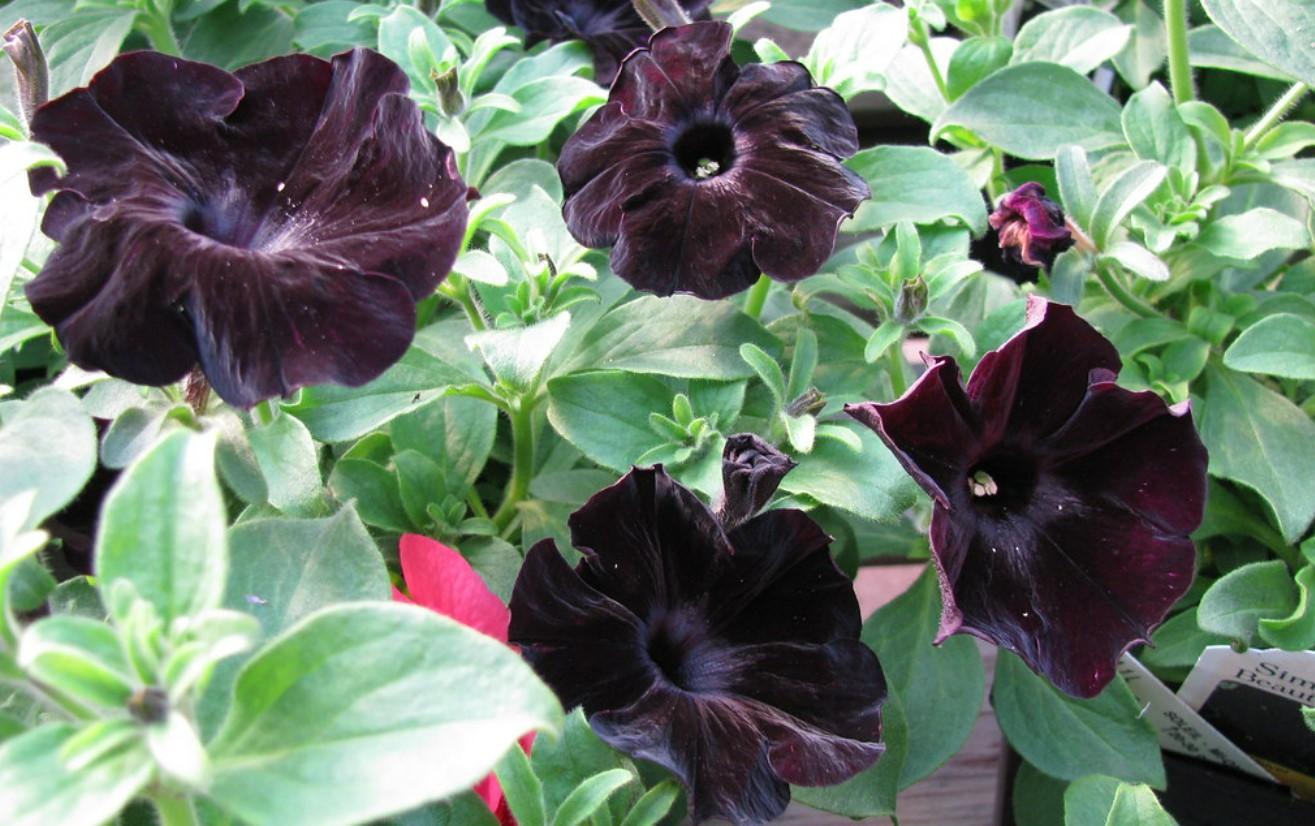Plants With Black Flowers - Names and Photos


One of the reasons we love growing flowering plants is the range of bright colors they can provide our garden. Among the green foliage, they cause bright bursts of blooms to catch the eye and evoke a bucolic idyll. One color we might not associate with such idyllic scenes is black. They do not appear as commonly in gardens as other brighter tones. This is the same for indoor plants. However, really dark flowers can bring some of the most beautiful contrasts to any flowerbed or potted plant design.
At thedailyECO, we share some of the most beautiful plants with black flowers. We share the names and care information about these plants, as well as photos so you can see how they might look in your garden, terrace, balcony or plant pot.
- Are there plants with black flowers?
- Black tulip (Tulipa)
- Black dahlia (Dahlia)
- Black columbine (Aquilegia vulgaris)
- Black iris (iris)
- Black tree mallow (Malva arborea)
- Black pansy (Viola × wittrockiana)
- Black petunia (petunia)
- Black gladiolus (Gladiolus)
- Black hellebore (Helleborus niger)
- Dusky crane's-bill (Geranium phaeum)
Are there plants with black flowers?
While our list of black flower plants certainly implies some plants have this hue, it is not technically the case. Dark flowers on plants may appear black, but this is not a pigment which is found naturally in flowering plants. Instead, they are plants with such dark colors that they appear black, but are usually very very dark purple.
The reason why any flower has any color is due to natural pigments which the plant produces. For the dark petals we can see on plants with black flowers, we look to the pigments known as anthocyanins. These are the natural pigments which provide the redness in blood oranges, the violet in purple broccoli and the black in blackcurrants. As with blackcurrants, the appearance of black flowers can be seen to be a very deep purple only upon close examination.
There is a very important reason why plants do not commonly have black flowers. Insects, birds and other pollinators are attracted to the bright petals of flowering plants. The color helps to show that they can find food, with the pollination of the plant being part of a symbiotic relationship plants have with their pollinators. Black petals mean a lesser chance of attracting pollinators[1].
It is for this reason many of the plants with black flowers we see today have had a little help. Cross pollination and genetic engineering from human intervention has allowed some flowers to have darker petals than they would otherwise in nature. Below we see some of the most common examples of plants with black flowers.
Find out about plants on the other side of the color spectrum with our guide to white flower plants for the garden.
Black tulip (Tulipa)
We begin our list of plants with black flowers with the black tulip. The tulip is a bulbous flower that is often more associated with reds or yellows, but tulips can be almost any color except blue. The black petals of a black tulip are an incredibly dark mauve color which appear black.
There is a unique fascination around black tulips compared to other flowers with black petals. This is thanks to Alexandre Dumas père choose ‘The Black Tulip’ for the title of one of his best-known literary works. When first published in 1850, a black tulip was purely a product of fiction. But the book caused a craze among horticulturalists to started a competition to create their own black tulip, the closest anyone doing so was in 1986.

Black dahlia (Dahlia)
Another black flower with literary allusions is the black dahlia. This is thanks to the novel of the same name by James Ellroy which was made into a film by Brian de Palma. While its name evokes mystery, it is the beautiful spiky corolla of this plant that makes it so well known. While dahlias are large flowers, they have beautifully serrated petals which are unlike most other plants.
If you want to add some dark beauty to your home or garden, black dahlias are a great option. They are relatively easy to cultivate, but we need to ensure they have plenty of water and sun. Learn about plant reproduction of these flowers with our article on what are spermatophyte plants?

Black columbine (Aquilegia vulgaris)
This rustic and perennial plant has bell-shaped flowers and bordered petals. The columbine can be found in a wide variety of colors, including black. The black columbine is known in certain cultures for its association with witchcraft. For this reason, it is also sometimes known as witch's herb in other languages. However true their magical properties might be, they are very toxic plants when ingested. This means we need to be very careful with pets and children if we expose them to these plants.

Black iris (iris)
This flower from Jordan and that you can find in colors as striking as pink or lilac, as well as black. It is a perennial plant capable of reaching up to 30 cm in height. Their height is reflected in the fact they are known as tall bearded (TB) irises. It has black or dark purple petals and sepals that sometimes end in a fine golden velvet, which gives an even more elegant and sophisticated touch.

Black tree mallow (Malva arborea)
Tree mallow is a species of mallow plants capable of bordering and covering various structures. This makes them great for growing on trellises, balconies or any similar plant-growing structures. Their color range tends to be somewhere between pink and purple, but there are varieties with petals so dark they appear to be black.
Learn about other purple plants for your home or garden with our related article.

Black pansy (Viola × wittrockiana)
The next on our list of plants with black flowers is the beautiful pansy, a hybrid plant which did not exist in nature. Rather, it was cultivated sometime in the 19th century. These plants often have bi-colored flowers, but, as you can see in the photo below, some appear almost completely black. The center of the flower has a beautiful yellow coloration, so these black flowers work in great contrast. They are ideal for the garden, but can be used as a potted plant.

Black petunia (petunia)
The petunia is a flower from the genus Petunia and is most appreciated for its great ornamental value. Despite their seemingly delicate beauty, petunias are relatively hardy flowers which can show great resistance to high temperatures. As with other flowering plants such as geraniums, petunias are plants that bloom during the summer to bring life to gardens and terraces. It is characterized by having fluffy leaves and large bell- or trumpet-shaped flowers that can present in black.
Petunias are part of the Solanaceae family of flowering plants, something you can learn more about in our article on deadly nightshade plants.

Black gladiolus (Gladiolus)
The next plant with black flowers on our list also includes an entire genus. Gladioli are flowers from the genus Gladiolus, well known for their large and very striking flowers. In addition to black, gladioli can be found in a wide range of colors. These include whites, pinks, oranges and purples. They bear resemblance to lilies, so much so they are sometimes known as ‘sword lilies’. This is due to a spiked inflorescence which is ideal for creating bouquets and centerpieces.

Black hellebore (Helleborus niger)
Also known as the Christmas rose, the black hellebore has a flowering season during the holiday period. They are simple black flowers made up of five petals and several stamens, which can have shades as varied as white, pink, green and, of course, black.
Hellebore is an evergreen plant which is particularly popular with horticulturists. This can be seen in the fact that many different cultivars and hybrids have been developed using these beautiful plants. Sometime in the future we may see even darker flowers in a specimen.

Dusky crane's-bill (Geranium phaeum)
We finish our list of plants with black flowers with one invariably known as the black widow or mourning widow flower. We can see why this might be the case since these flowers are so dark they appear almost black. It prefers humid and shady areas to grow, but they are very resistant.
Their flowering season is between late spring and early autumn. Its bell-shaped structure and striking stamen make it a really attractive flower to use both in gardens and on balconies or terraces. Although the dusky crane's-bill is a perennial flowering plant, you can learn more about how plants bloom with our article on annual plants definition and examples.

If you want to read similar articles to Plants With Black Flowers - Names and Photos, we recommend you visit our Decorative plants category.
1. Ahmad, S., Chen, J., Chen, G., Huang, J., Zhou, Y., Zhao, K., Lan, S., Liu, Z., & Peng, D. (2022). Why Black Flowers? An Extreme Environment and Molecular Perspective of Black Color Accumulation in the Ornamental and Food Crops. Frontiers in plant science, 13, 885176.
https://doi.org/10.3389/fpls.2022.885176















